

Our Environment. Wind power is one of the healthiest forms of electricity Wind is among the healthiest of all renewable electricity generation sources, and all experts agree on the negative health impacts of air pollution from burning fossil fuels.

Wind power has no adverse health effects on local residents. WIND FOR ME. Wind power is helping to make Maine more self-sufficient and less vulnerable to fluctuations in the price of fossil fuels.
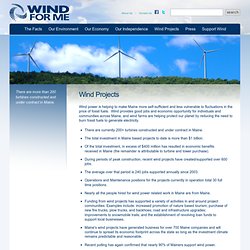
Wind provides good jobs and economic opportunity for individuals and communities across Maine, and wind farms are helping protect our planet by reducing the need to burn fossil fuels to generate electricity. There are currently 200+ turbines constructed and under contract in Maine. The total investment in Maine based projects to date is more than $1 billion. Green Power. Energy is one of the most basic elements of our society today - it powers our homes, businesses and even our vehicles.
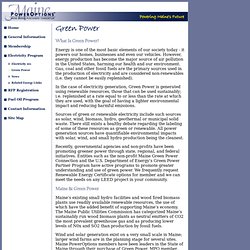
However, energy production has become the major source of air pollution in the United States, harming our health and our environment. Gas, coal and other fossil fuels are the primary sources used in the production of electricity and are considered non-renewables (i.e. they cannot be easily replenished). In the case of electricity generation, Green Power is generated using renewable resources, those that can be used sustainably; i.e. replenished at a rate equal to or less than the rate at which they are used, with the goal of having a lighter environmental impact and reducing harmful emissions.
Sources of green or renewable electricity include such sources as solar, wind, biomass, hydro, geothermal or municipal solid waste. There still exists a healthy debate regarding the labeling of some of these resources as green or renewable. Two Contrasting Views Of Our Energy Future. The issue of where we will get our energy from in the coming decades is becoming ever more urgent.
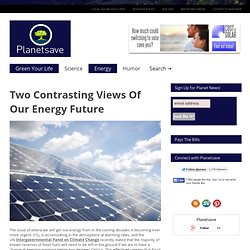
CO2 is accumulating in the atmosphere at alarming rates, and the UN Intergovernmental Panel on Climate Change recently stated that the majority of known reserves of fossil fuels will need to be left in the ground if we are to have a chance at keeping warming below two degrees Celsius. This effectively means that fossil fuels must be phased out as soon as possible. But what are we going to replace them with? Bearing in mind that nobody wants to return to the dark ages, there is a pressing need to come up with viable alternatives, which can provide substantial amounts of energy, and which can do so quickly. I have recently read two very different visions for our shared energy future.
Green Inventions That Could Change The Way We Live. In 2013, we’re all aware of the environmental dangers that the planet is currently facing.
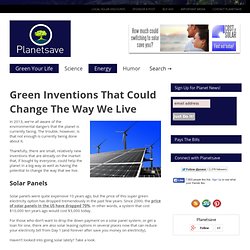
The trouble, however, is that not enough is currently being done about it. Thankfully, there are small, relatively new inventions that are already on the market that, if bought by everyone, could help the planet in a big way as well as having the potential to change the way that we live. Solar Panels Solar panels were quite expensive 10 years ago, but the price of this super green electricity option has dropped tremendously in the past few years. 4 Green Gifts That Will Keep Green In Your Pocket. You often have to invest money (or time, which is money) in order to make money.

Some investments are smaller and have quicker payoffs, while some investments are larger and have longer (though, often more significant) payoffs. The nice thing about money-saving investments in the home is that these investments often also save energy — which protects our climate, air, and water; which then keeps us healthier and safer, saving us… money. 11/14/2013: Maine Companies Honored by Northeast Diesel Collaborative for Efforts to Reduce Air Pollution. Release Date: 11/14/2013Contact Information: David Deegan, (617) 918-1017 (Boston, Mass. – Nov. 14, 2013) – Two Portland Maine businesses recently were praised by an EPA partnership for their efforts to reduce air pollution from diesel emissions.
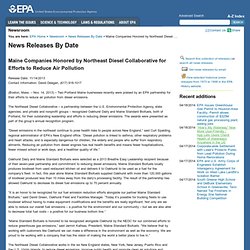
The Northeast Diesel Collaborative – a partnership between the U.S. Scottish power: rich in green energy but light on green revenues. So Scotland could be the Saudi Arabia of renewables.
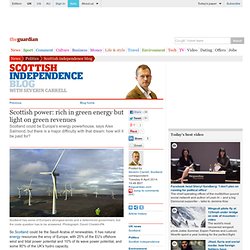
It has natural energy resources the envy of Europe, with 25% of the EU's offshore wind and tidal power potential and 10% of its wave power potential, and some 90% of the UK's hydro capacity. Alex Salmond was keen to stress how significant those resources could be for Scotland, and for his case for independence, when he addressed the Bloomberg Future of Energy Summit in New York on Tuesday: Gulf of Maine Research Institute. The Gulf of Maine Research Institute's newest education initiative, PowerHouse, empowers 7th and 8th grade students to analyze actual home electricity consumption data collected using smart electrical meters.
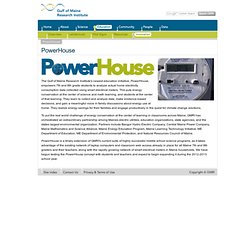
This puts energy conservation at the center of science and math learning, and students at the center of that learning. They learn to collect and analyze data, make evidence-based decisions, and gain a meaningful voice in family discussions about energy use at home. They realize energy savings for their families and engage productively in the quest for climate change solutions. Farms sprout in cities. Farming in the city is already happening on the small scale.
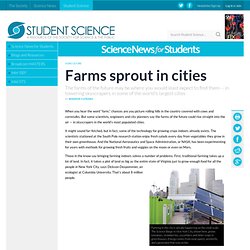
The Science Barge in New York City, shown here, grows tomatoes, strawberries, cucumbers and other crops in greenhouses. Energy comes from solar panels, windmills and a generator that runs on bio When you hear the word “farm,” chances are you picture rolling hills in the country covered with cows and cornstalks. But some scientists, engineers and city planners say the farms of the future could rise straight into the air — in skyscrapers in the world’s most populated cities.
It might sound far-fetched, but in fact, some of the technology for growing crops indoors already exists. President Talks "Homegrown Energy" President Barack Obama speaks during a town hall meeting after touring the Gamesa Technology Corporation wind-energy turbine manufacturing facility April 6, 2011 in Fairless Hills, Pennsylvania. (Photo: AFP PHOTO/Mandel NGAN) By the year 2035, 80 per cent of the electricity used in the United States should be generated from clean energy sources, said President Barack Obama in a speech on Wednesday. President Obama visited the Gamesa Wind Turbine factory in Fairless Hills, Pennsylvania to talk about an alternative energy policy he unveiled last week. Obama hopes to cut back U.S. dependence on foreign oil imports and regain America's leadership as an innovator of technology. "I love visiting places where people are actually making stuff, because that's what America is about," Obama told Gamesa employees and their families.
Alternative Energy. Wind Farms Disrupting Radar, Scientists Say. Rainstorm or wind farm? The circled area contains a wind farm, making it unclear whether it is also raining there.National Weather Service This one's really off the radar. Pros & Cons of Solar Energy. Countries all over the world are using solar energy in order to generate electricity, but why is the use of this energy source so popular?
What is it that makes solar power one of the most used renewable energy technologies available today? In this article we will be taking a look at the many different pros and cons of solar energy in order to answer this question. Pros of Solar Energy 1. Renewable Solar energy is a renewable energy source and is something we will never run out of as opposed to non-renewable energy sources such as coal, oil and gas. 2. Solar panels give off no pollution making them an environmentally friendly option for producing electricity.
Although pollution is produced during the manufacturing and transportation of solar panels, once they are up and running they will help to offset these effects by providing a source of clean electricity that might otherwise have been produced using less environmentally friendly options. 3. 4. 5. 6. 7. 8.